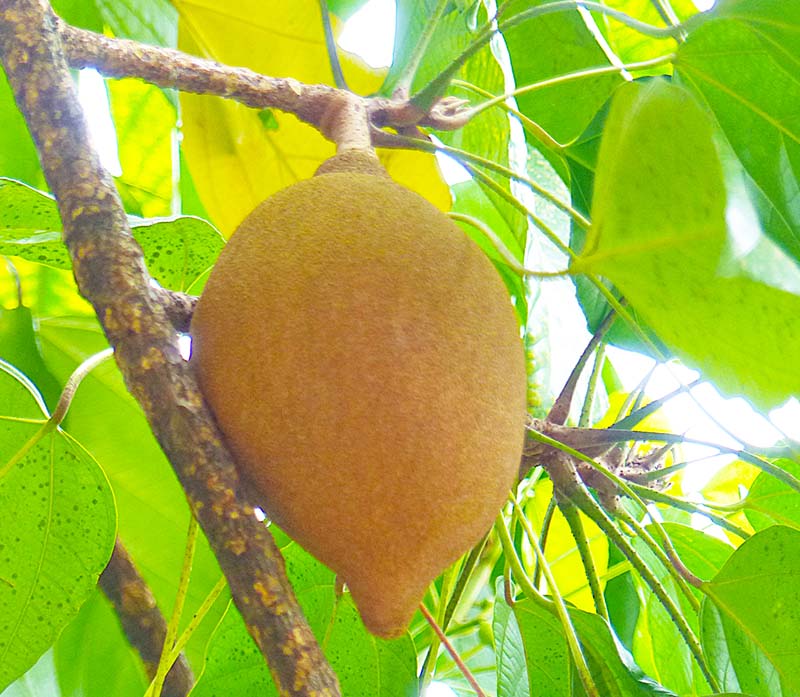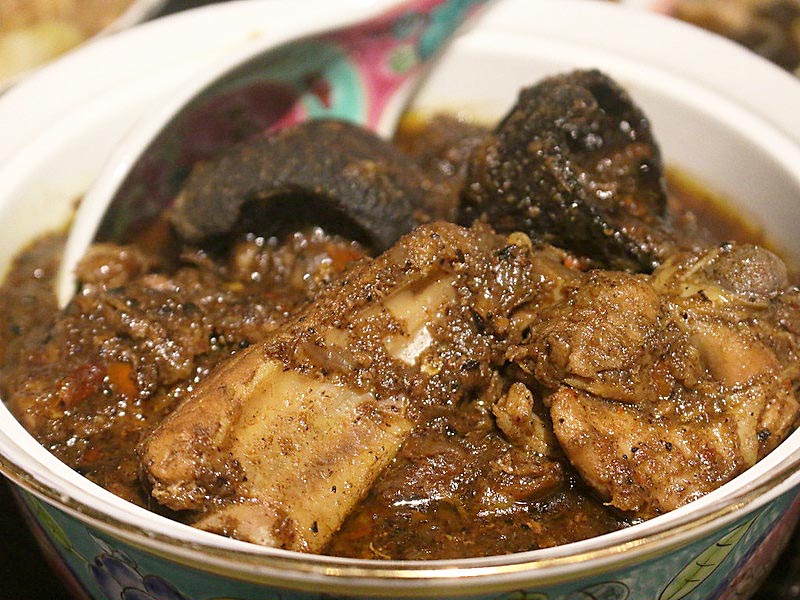The Buah Keluak (Pangium edule) tree is also known as Kepayang and Kluwek, it is native to South-East Asia region- Singapore Malaysia and Indonesia. The Buah Keluak tree belongs to the Achariaceae family of shrubs and trees begins to bear fruit at about age 15. Buah Keluak is called 黑果 in Chinese. After various processes of buried fermentation, soaking and frying, seeds of Buah Keluak fruit are used in cooking in Malay, Indonesian and Peranakan (Straits Chinese) food.
Buah Keluak as an ingredient in Peranakan Cusine
In the South East Asia region, the Buah Keluak seeds are either fried with their shells intact or with only the meat inside and the shells discarded. In Singapore, the best-known Buah Keluak dishes are Ayam Buah Keluak (chicken stew) and Tulang Babi Buah Keluak (pork rib stew). It may also be combined with prawns and pork and packed back into the shells to be fried or wrapped in banana leaves and steamed or grilled with spices. As it incorporates a host of Southeast Asian spices and Chinese slow cooking method, Ayam Buah keluak has come to be seen as a symbol of Peranakan cuisine.
The black, oily Buah keluak is described as an acquired taste, reminiscent of cacao (used in the chocolate making), mushrooms and black olives. Some also call it the Asian black truffle alternative, as connoisseurs attest that Buah keluak tastes like the highly coveted fungus and has been used in some fine dining menus.
Removing the poison found in Buah Keluak seed
The Buah Keluak tree is a poisonous tree with fruits filled with seeds.

The toxin, hydrocyanic acid, exists in the entire tree including fruits and seeds. Before using the Buah Keluak seeds for cooking, there are steps to eliminate the toxin. Using poorly prepared or unripe seeds may cause vomiting, stomach swelling, tongue contraction, or even death.
How to choose a larger Buah Keluak kernel
- Pick heavier Buah Keluak seed, as the light ones are usually dry and have little meat.
- Shake it intensely and listen to the sound that the kernel makes when shaking it and estimates its size.
Preparing Buah Keluak for cooking
Traditionally, there are a variety of methods used for draining Buah Keluak from its poison and preparing it as food. Typically, the fruit is left to mature until the flesh falls away, after which the seeds are removed.
Using fermentation process
Through the fermentation process, boiled Buah Keluak seeds are buried in a pit and left to ferment over 40 days, This will modify their taste and reducing the hydrocyanic acid toxicity. Most Buah Keluak imported into Singapore is using this method.
Soaking Method
- Placed the seeds under running water.
- Soak it for about 5 days, scrubbing away the dark coating and changing the water every day.
- Crack open the nut with a small knife and remove the kernel from the seeds.
- The kernel can be crushed and then filter through a sieve or use a food blender to make a smooth paste for cooking.
- The kernel should be boiled and placed under running water for a day before use for food preparation.
Where to buy Buah Keluak seed in Singapore
When purchasing from the stalls, check with the owner if Buah Keluak is ready to be cooked. This will shortened the preparation process as mentioned above.
- Tekka Market – #01-210 Mr Seah
- Address: 665 Buffalo Road, Singapore 210665
- Geylang Serai
- Address: 1 Geylang Serai, Singapore 402001
- Chinatown Wetmarket
- Chinatown Complex, 335 Smith Street, Singapore 050335
Additional Uses
Besides food, Buah Keluak seeds can also be pressed after boiling, soaking, and drying in the sun to obtain an oil that can replace coconut oil. Besides frying, the oil can be used in soap making.
There are medicinal and preservative applications for Buah keluak, as it has anthelmintic (removing parasitic worm) properties. In western Java, Indonesia, pounded seeds – with antiseptic properties – are put within the body as they are transported to the market, while freshly crushed seeds are added by the Malay community to boil. In Pahang, Malaysia, crushed seeds are used to attract and paralyse fish.

